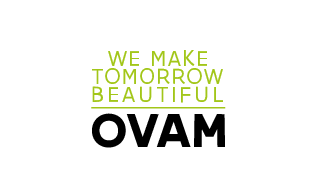18. Grass management: mobilisation strategies & a circular perspective
 This study investigates six mobilisation strategies for grass from road verges and nature reserves in Flanders, complemented with a holistic circular perspective on grass as a secondary raw material.
This study investigates six mobilisation strategies for grass from road verges and nature reserves in Flanders, complemented with a holistic circular perspective on grass as a secondary raw material.
Management of road verges and nature reserves produces a large quantity of grass cuttings every year. The total grass acreage sums to 29.600 ha distributed over nature reserves (15.050 ha or 50%), municipal road verges (10.300 ha or 35%) and highway & regional road verges (4.250 ha or 15%). The total harvestable grass from road verges and nature reserves in Flanders amounts to circa 427.000 tonnes fresh matter or 141.000 tonnes dry matter each year. Composting, and to much lesser extent anaerobic digestion, are the established processing options in Flanders. However, the processing of grass fibres into bio-materials is investigated
such as alternative emerging processing options. At the same time there is a significant amount of grass potential that remains unharvested, unprocessed and/or are exported. Still, processing of these cuttings is a problem rather than an opportunity and comes at a high societal cost. At the same time, Flanders sets ambitious goals for further deployment of grass cuttings in a circular bio-based economy.
This study investigates six grass mobilisation scenarios – one AS IS and five TO BE scenarios. The scenarios are in line with policy ambitions put forward and take into account all major characteristics throughout the supply chain; such as origin-destination (transport & storage), quantity (acreage & production), quality (harvest type & litter) and planning (peaks & seasonal effects). The results show how each strategy can be met at minimised mobilisation costs. The AS IS scenario reflects the current situation for processing grass cuttings, i.e. green composting and processing of a part of nature grass towards feed. This scenario sets the baseline for total mobilisation cost and other KPIs being; the total mileage and the number of vehicle movements. The five TO BE scenarios investigate potential future scenarios. Each scenario differs in i) type of end-processes, ii) the capacity of the end-processes and/or iii) the allowed feedstock quality for the end-process. This differentiation allows to test the impact on mobilisation cost of each scenario.
To address the complexity of mobilisation scenarios, VITO’s MooV model has been used (https://moov.vito.be). MooV is a supply chain optimisation model that analyses different scenarios in search of the best value chain configuration within a geographical context. This with the general objective to increase mobilisation rates and reduce risks and costs.

.png)






